A PHOTO DISCUSSION ON NUTTING'S
FLYCATCHER IDENTIFICATION:
Part 6: Personal conclusions
[including
an update in fall 2003]
text © 2003 Don Roberson
all photographs are copyrighted © 2003
by the photographers cited; used here with permission
In the preceding set of pages, I have laid out a lot of evidence
and sorted through a lot of literature, trying to present things of importance
but permitting the reader to make his or her own evaluations of that evidence.
I strongly suspect, however, that my opinion is nonetheless obvious at
various points. This is a source of bias, and should be addressed before
going on to my personal thoughts about the identity of this Santa Cruz
bird.
BIAS: As one of those initially identifying
this bird as a Nutting's, it can fairly be said that I am now biased in
favor of Nutting's. I did not have this bias, however, when going up to
look for it. At that point I was neutral about identification, understanding
only that there was an interesting Myiarchus that had points against
Dusky-capped and had some features described that sounded to me like Nutting's
(no one suggested it was a Nutting's to me initially). Even at that, it
is fair to say that I have a bias toward the concept that well-seen birds
can be identified in the field, but often only with appropriate field or
museum experience, or after literature research.
I think it is also fair to say that there are a set of keen birdwatchers,
often with an ornithological background, who come with a bias that some
birds cannot be identified in the field. This comes from various sources
— for some it is a strong preference for specimen evidence1
or those jaded by mistaken field claims in the past (the late Allan Philips
was among those; his disciples follow some of these footprints), for others
it is a philosophical approach that it is the process that is interesting,
not the end result (they tend to say things like "why do we have to put
this is a particular box?" or "I prefer to leave this unresolved"). I think
it is fair to call them 'conservatives.' There is another field-oriented
set who are confident about their field skills and feel they can identify
most anything. Perhaps we could call them 'liberals'. I prefer to think
of myself more in the middle — with my mug on one side looking at the bird,
and my rump on the other side, bogged down in the literature and museum
research — a 'mugwump', if you will (a good old-fashioned political term
from the 1870s). It is also fair to say that I come from a legal background,
where one marshals evidence to argue for a particular result, and generally
believes that one can reach a conclusion. These biases will undoubtedly
appear throughout these pages. You will find some bias in almost anyone
in the scale of liberals to conservatives when it comes to reviewing bird
records.
I believe that science is best served by reviewing the evidence available
and drawing the conclusion (i.e., the identification) best supported by
the evidence. Ornithologists do this all the time in other ways. The taxonomic
order of birds on the A.O.U. Check-List, or any checklist, is simply a
hypothesis, based on the best evidence at the time, of the relationships
of the birds listed there. Hardly an issue of an ornithological journal
appears without new evidence that could affect the order of the checklist,
sometimes dramatically. Yet, we do not avoid making checklists because
we don't have "all the evidence." We will never have "all the evidence."
We can only work with the evidence currently available. If more evidence
is developed later, great! We can change our conclusions at that time.
But I do not see the fact that additional evidence may come to light as
a reason to leave a bird unidentified when, giving proper weight to that
evidence, we can reach a current conclusion that is consistent with the
evidence. If my evaluation (below) is wrong and new evidence supports a
different conclusion, I will simple revise my evaluation at that time,
just as we revise our checklist order from time to time.
PERSONAL EVALUATION: Notwithstanding the
elements of bias, and recognizing that this is the least important of this
set of pages, here is my analysis of the Santa Cruz flycatcher:
SIZE &
SHAPE |
One cannot adequately evaluate size from photos, although in the field
I always felt it was small and dainty, rather than mid-sized and rangy
like Ash-throated. To my eye the Santa Cruz bird is a very good match in
shape to the s. Calif. & Arizona Nutting's, and lacks the long wings
of Ash-throated. Most importantly, although there is overlap in bill lengths,
this bird was not only short-billed but thick-billed and broad-billed at
its base. This is entirely consistent with Nutting's, and would be a very
odd Ash-throated, indeed. These features favor Nutting's. The pink color
at the gape and base of lower mandible is also consistent with Nutting's,
and rather rare in Ash-throated. |
 |
PLUMAGE
COLOR |
Another set of characters impossible to evaluate on photos. Lighting
conditions and film type (or the character of the scope in digiscoped images)
are critical. All photos in the sun wash out the color saturation. The
particular photo (right; © D. Roberson) is a good match to what I
saw in the field: rather darkish gray breast well separated from yellow
belly, and contrastingly dark auriculars. Also no gray nuchal collar. These
are consistent points with Nutting's but, given the difficulty in photo
review and even in field observations without comparative material, Ash-throated
cannot be ruled out on these points. Reviewers can pick a number of photos
to try to show the opposite of my evaluation. Perhaps this should be called
"neutral" although I feel that the auricular/throat contrast in particular
favors Nutting's. [The rusty-edged uppertail coverts are consistent with
Nutting's, and may favor it significantly, but more evidence is needed.] |
 |
TAIL
PATTERN |
In the field I saw rufous inner webs extending to the tip of R6, and
I believe that this is shown by the photos on my "tail pattern" page in
this series. Although there is a broadening of the brown at the tip, it
is comparatively gradual. In this view (© Tom Grey) of the wet tail
from above, this pattern may be even more obvious. I easily see this as
within pattern 2A in Lanyon (1961), a typical Nutting's pattern. It can
also be matched by pattern 1E, a rare Ash-throated pattern. While I feel
that the tail is quite typical for a Nutting's, it also does not rule out
Ash-throated, so the character is evaluated "neutral." |
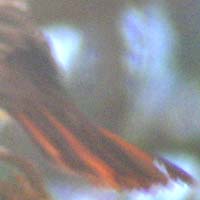 |
MOUTH
LINING |
In the field, I saw the inside of the upper mandible as orange. In
this photo is looks bright pink to my eye, but we saw that the color picker
chose a maroon. In any event, it is a bright color. In no way is it "flesh"
or "dull yellowish" as is typical of Ash-throated. Those claiming to see
a dull color in the field may have seen the inside of the lower mandible.
So, again, the mouth lining to me was typical of Nutting's but, as detailed
on another page, this character may be subject to age-related variation.
Thus it is not conclusive; rather, this character simply favors Nutting's. |
 |
CALLS &
BEHAVIOR |
It seems hopeless to sort between written renditions of vocalizations
by different observers. Yet, between hundreds of calls over weeks of observation,
the bird never gave any typical Ash-throated calls. It's 'standard' call
was whistled, short, and sharp — I said whik! and others used other
words (pweep, etc.). Even one who thought the calls could match
Ash-throated agreed it was a whistled wip!.The two observers spending
the most time eventually heard longer, upslurred wheet calls, said
to be diagnostic of Nutting's. I did not hear those, but those I did hear
seemed well outside my experience with Ash-throated. I judge the calls
as likely diagnostic, but obvious that is simply a personal opinion.
As to behavior, its olive-eating habits were consistent with what we
know of Nutting's and inconsistent with many Ash-throats. Doesn't rule
out Ash-throated, but favors Nutting's to some extent. |
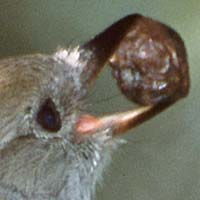 |
WING
PANEL |
Useful only if one knows the age of the bird in question. Birds with
retained juvenal secondaries, like many vagrant Myiarchus eastward
in fall, cannot be identified by wing pattern. Those birds have first-basic
tails (molted on summer grounds) but retained juvenal outer secondaries
(molt suspended during migration). Fortunately, we know that the Santa
Cruz bird is in first basic plumage because there is a retained mid-secondary
(S5) but we can see very fresh round-tipped outer secondaries (S1-S4).
We can see these without dispute only because of the high quality digital
photos by Kevin McKereghan. Field notes were inadequate to provide anything
more than a suggestion of the important points. In the field I saw the
'mid-panel' as "lemon yellow" (meaning "pale yellow") and they appear that
way in film photos in natural light. This color is washed out in McKereghan's
photo but I believe it is indisputable that the edges of S2-S4 are the
same color as the belly in his shots. McKereghan's photos are superb for
details but demonstrably washed out on color saturation. |
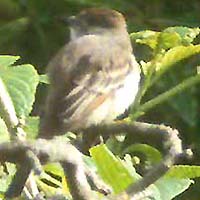 |
SECONDARY
EDGES (1) |
Other photos (like Tom Grey's digiscoped image, near right) show the
panel as more cinnamon, but this is also a photographic artifact. The color
was not this rusty; at most it looked pale yellow on S2-4 in the field.
When I blow up the McKereghan photo to an extreme (far right), these feathers
have a complex tri-colored pattern of whitish, pale tan, and fuscous. A
secondary "mid-panel" that grades from rufous to orange (=cinnamon) to
pale yellow or pale tan is the classic Nutting's pattern according to Lanyon
(1961). There is not evidence it can ever be shown in post-juvenal Ash-throats.
Even texts that suggest there can be a yellowish tone to secondary edges
in Ash-throated (e.g., Howell & Webb 1994, 1995) do not claim that
S1 can ever be deep rufous in Ash-throated. |
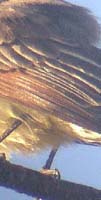  |
SECONDARY
EDGES (2) |
It is that outermost secondary (S1) that is critical on a known-age
bird. The fresh outermost secondary (S1) of the Santa Cruz bird had an
extensively deep rufous edge, very similar in color to the deep rufous
edges of the inner primaries. The next secondary (S2) has a rufous-edged
base and quickly becomes more orange-yellow. According to Lanyon (1961),
these points eliminate first-basic Ash-throated entirely. Recall that Lanyon
(1961) considered the secondary pattern useful in late fall because the
colors faded in winter. In the freshest late fall Ash-throated, the S1
edge is normally white or, at most, "pale rufous." In contrast, he says
the Nutting's S1 is always deep rufous. By January, any "pale rufous" on
S1 of Ash-throated would be faded considerably (to something like whitish)
and recall that the vast majority of Ash-throated have S1 edges that are
white from their inception. There is no evidence to suggest that Ash-throated
ever has a first-basic S1 with an extensive deep rufous edge, closely matching
the color of P1's edge, like McKereghan's photo (right) shows. |
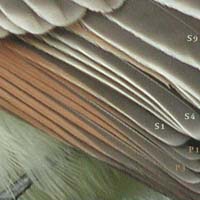 |
BOTTOM LINE: There is no character on this
bird that favors Ash-throated. Every point is either neutral or favors
typical Nutting's. Such an accumulation of evidence strongly supports the
identification as Nutting's. Perhaps most important, the combination of
the bill size and shape, plus the wing panel character , and specifically
the deep rufous color throughout the edge of S1, tips the identification
into the "positive" category. The calls are consistent, and those heard
by others are apparently diagnostic. I believe that the bird is a Nutting's
Flycatcher.
I have seen reviews that considered this bird an Ash-throated. I believe
them to rely much too heavily on single photos, and particularly they rely
on the McKereghan photos — not for the rufous-edged S1 that those reviewers
mostly ignore — but for claims that S2-4 were white (like Ash-throated),
and that the auriculars are gray (like Ash-throated, but ignoring the contrast
shown). McKereghan's shots are wonderful and are, indeed, the key to the
whole puzzle, but they do not show true color saturation. They show detail.
Even at that, when properly used, they show the edges of S2-4 to be pale
yellow (per the color picker) to a tri-colored pattern of white, pale tan,
and fuscous (extreme close-up). Either color statement is consistent with
the gradually changing 'mid-panel' pattern of Nutting's.
Other negative reviews have relied on "retranslation" of calls (i.e.,
they read into the details a whit-like call, even though no one
heard a soft, lazy whit). It seems probable, however, that some
of the soft short calls of Nutting's cannot be separated from some soft
short calls of Ash-throated. It is the quality of the louder, sharper calls
that are more important. Those calls I described included exclamation points
to emphasize sharpness and upslurred energy. Some have relied on evidence
of "flesh-colored" mouth linings, but, as demonstrated, all the photographic
evidence is of bright colors on the mouth linings (a Nutting's feature)
and dull colors inside the lower mandible (a feature shared by both species).
Typically "orange" mouth linings were seen by many in the field.
This is a particularly interesting Nutting's because it is a first-year
bird, rather than an adult as were the southern California and Arizona
birds. I believe we can learn from this bird. Hypotheses supported by this
bird include:
-
first-winter Nutting's average slightly paler plumage and secondary edge
colors than adults
-
first-winter Nutting's could possibly show duller mouth lining colors than
adults
These hypotheses are just that: statements logically suggested by the evidence
of one (1) bird to be tested against a larger set of data over time. They
may or may not be true.
|
CODA: Update in September 2003
All of these preceding pages were written in February 2003. A few people
have asked if my personal opinion has changed given the new information
now available
on Joe Morlan's web site, and especially given his September 2003 statement:
"I believe the recordings and sonograms provide compelling evidence that
this bird was an Ash-throated Flycatcher." The short answer to whether
this changes my opinion is "no." A more expansive response follows.
|
| The video-tape and songogram:
All that is "new" is that a videotape which included the standard soft
call of the Santa Cruz bird has been digitized and sonogramed. This is
the call written variously as qwip, pwik, or wip!
and was given hundreds of times each day. I have personally reviewed the
videotape; this is the only call on the tape. None of the alternate calls
heard during the bird's stay is on the tape.
In the preceding discussion, we have already seen (through a literature
review) that it appears all four Myiarchus have a soft wit-like
call. My conclusion on this topic in February was "It seems probable, however,
that some of the soft short calls of Nutting's cannot be separated from
some soft short calls of Ash-throated." In other words, nothing about this
soft call was going to get us very far.
Since February, Joe Morlan has added various sound cuts to his web page
discussion, including the soft wit call of Ash-throated from a wintering
bird in Mexico and recorded by Alvaro Jaramillo. Also included are two
cuts of Nutting's from Mexico. Both are of birds interacting with another
Myiarchus
and are possibly the calls of interacting pairs. There is no cut of a single
soft-calling Nutting's. However, I pointed out that one of the Nutting's
cuts includes two introductory notes that are rather like soft wit-like
calls. These are not "stand-alone" notes and may or may not be similar
to the pit note described by Lanyon for Nutting's.
I have reviewed the video-tape of the Santa Cruz bird with the Mexico
cuts of both species. There is a strong similarity between the Santa Cruz
bird's soft call and the winter Ash-throated, but to my ear it was not
identical. I disagree with Joe's June statement that "To me, the vocalizations
sound exactly like the winter-calls of Ash-throated Flycatcher on my reference
page." Rather, I think they are very similar but not that different in
quality from the soft wit-like calls that are the introductory notes in
one set of Nutting's, excepting, of course, that the Nutting's tape is
a lot louder in intensity as the calls are introductory notes that then
go into a vigorous set of other calls.
The new songogram evidence compares the Santa Cruz soft call with the
winter Ash-throated and the two softer introductory notes of the Nutting's
cuts. I emphasize again, however, that there is no comparison at all with
a soft-calling lone Nutting's. Rather, the two introductory notes on that
cut of Nutting's otherwise includes much more vigorous calls, and all cuts
of Nutting's calls are of birds vocalizing in response to another Myiarchus.
The Nutting's cut is substantially louder in volume/amplitude than the
Ash-throated or the Santa Cruz cut.
I do not have much training in reading sonograms but I see in this comparison
that none of the cuts are "identical" to any other. The cuts of Santa Cruz
and Ash-throated are most similar to each other but the difference from
the Nutting's "soft call" looks to me to be primarily one of amplitude
(intensity = loudness) and not of structure. Morlan includes the wheep
call of Nutting's for comparison, but no one ever suggested that the Santa
Cruz soft call was the loud wheep note, so its inclusion in the
set only serves to bias the comparison. He should have included the ka-brick
of Ash-throated in the series to equalize the comparative choices.
So at the end of the whole effort (which is appreciated) we are left
pretty much at the same place where we were last February. The Santa Cruz
soft call might well be matched by Ash-throated and might well be matched
by Nutting's. We now have firmer evidence it matches Ash-throated but we
lack any firm evidence that it does not match the soft pit
call of Nutting's. We have no lone soft-calling Nutting's example to make
that comparison. I still suspect that the soft wit-like calls of all four
species are close enough that identification on that point alone will always
be insufficient. No evidence to the contrary has yet been presented.
In addition to all this, the sample sizes used for this "new" conclusion
are incredibly small. A sample size of Ash-throated is one (1) winter bird.
The sample size of Nutting's is zero (0) lone calling birds, and one (1)
Nutting's with two introductory notes that may or may not be an example
to the pit call. In short, this "new" evidence is, perhaps, much
ado about nothing. |
| Museum research
In March 2003, Joe Morlan and Dan Singer reviewed specimens at the California
Academy of Sciences. Morlan has usefully summarized their findings on-line,
and I quote a bit of them here, with Morlan's comments in italics and my
thoughts in regular type:
Morlan wrote: Lanyon's statement about the difference in the amount
of rust on s1 is not supported by our specimen research. The secondary
pattern shown by the Santa Cruz bird seemed more consistent with Ash-throated
Flycatcher. However, it was also consistent with Lanyon's descriptions
of Nutting's and perhaps a larger collection of Nutting's would show more
variation.
I am unable to evaluate this finding because I have yet to visit a museum
with sufficient resources. I am a bit skeptical about this finding, and
I note that Joe admits that another and larger series might support Lanyon's
research. Lanyon's work was with a much larger series of specimens than
the rather small series of winter birds at CAS. However, the Morlan/Singer
finding does call into question the usefulness of the s1 edging character
that I had previously emphasized.
Morlan wrote: In my opinion, the size and shape of the bill of the
Santa Cruz bird is consistent with Nutting's, and not Ash-throated. The
chest pattern, nape pattern, and rump color seemed to me to be better for
Nutting's, but it is difficult to draw firm conclusions from the specimens
we examined.
These conclusions are the same as I reached through an analysis of photos
in the preceding pages. Joe and Dan did not look at primary extension in
specimens for reasons described on Joe's site, but that is also another
compelling pro-Nutting's feature. Joe's site does have some color photos
of specimens that suggest that the uppertail covert/rump pattern may be
a stronger pro-Nutting's feature than previously known. In other words,
excepting only the questioning of the s1 pattern are a good pro-Nutting's
character, the museum research generally supported the idea that the Santa
Cruz bird was a Nutting's.
Morlan wrote: The most compelling argument for Nutting's remains
the voice. [emphasis added]
Since I know that neither Joe nor I thought the soft wit-like call was
diagnostic last winter, I can only presume from this March statement that
Joe was relying on the following information, quoted here from his web
site (emphasis added):
-
3 Feb 03; David Suddjian relocates the bird at new spot, 217 Sherman St.
Characteristic
Nutting's calls are heard.
-
4 Feb 03; Al Jaramillo and Chris Benesh kindly contribute reference audio
clips of both species which I add to my reference page here. David Suddjian
and Steve Gerow, who have been following the bird recently, match what
they have been hearing with the clips of known Nutting's and not of Ash-throated.
I agree that the descriptions by local Santa Cruz birders who spent much
more time with the bird than anyone else are important. Only they documented
a fuller range of vocalizations, and this greater range of vocalizations
included those that they matched to tapes of Nutting's. I am also aware
that some discount these observations on the grounds that Suddjian and
Gerow lack experience with Nutting's. This seems a rather biased attitude.
Both have extensive experience with Ash-throated and simply stated that
the range of calls heard — above and beyond the soft call — were inconsistent
with Ash-throated calls and were matched to tapes of Nutting's. |
| Wrap up
Morlan now (16 Sep 2003) says: "I believe the sonograms show the vocalizations
are consistent with Ash-throated Flycatcher and inconsistent with Nutting's
including the soft calls of Nutting's."
For reasons set out above, I think this statement is well outside the
bounds of the available evidence. It is possible that it is a true statement,
and if it were shown to be true my conclusions would indeed change, but
currently the evidence does not support this strong conclusion. Without
an adequate sample of Nutting's, the fact that tapes of the soft calls
of the Santa Cruz bird are similar to soft calls of winter Ash-throated
does not rule out the possibility that they may also be similar to the
soft calls of non-paired Nutting's. There is simply inadequate evidence
to make this determination.
This new statement also entirely ignores the range of variation and
the other calls documented by Santa Cruz birders. I think that primary
emphasis on an ambiguous soft call that can probably be matched by either
species is unwarranted.
It is still my opinion that the bill size and shape, plumage patterns
on face and chest, uppertail covert/rump color, short primary projection,
mouth lining color, behavior, and classic Nutting's tail pattern all strongly
suggest that the Santa Cruz bird was a Nutting's, and that its soft call
was inconclusive as within the category of calls apparently shared by all
Myiarchus
of this set. I also note again that local observers who spent much
more time with the bird than anyone else never heard "standard" Ash-throated
calls and, instead, heard loud calls that are consistent with the diagnostic
notes of Nutting's. |
| The future
As has been the case with some past records of difficult birds, this
Santa Cruz record has now taken on a life of its own, and much of the current
climate may be associated with birding politics and various peer pressures.
The California Bird Records Committee is purposefully constructed to be
conservative [i.e., it takes only 2 of 10 votes to reject a record] and
there is little doubt that the claim of Nutting's will not be accepted.
You can expect to find this listed as a "rejected" record in due course.
This does not necessarily mean anything. The Committee has been wrong
in the past and will be wrong again in the future. Sometimes they re-review
a record a decade later and correct a mistaken conclusion; sometimes they
do not. There is a certain randomness to these things.
It may be that additional evidence will add to our understanding of
this bird. It is possible that it could return this next winter and be
trapped and examined in-hand. This may prove conclusive one way or the
other. Likewise, it is possible that it could return and that other calls
would be captured on tape, and that they would be conclusive. It does not
seem to me, however, that an analysis of the "soft" call will be of that
much value absent a much better understanding of the range of calls given
by Nutting's.
It is also possible that future experiences with a different bird, or
a more lengthy museum project, will prove or disprove the usefulness of
features such as bill shape, primary projection, s1 pattern, and uppertail
covert/rump color, and shed further light on this Santa Cruz individual.
I strongly recommend that each of you review the evidence for yourself,
and reach your own conclusion. This bird is particularly interesting because
there is a lot of physical evidence that each of you can review. You have
before you, either on this site or Joe Morlan's site, a good chunk of the
information that will be reviewed by the CBRC and others. You need not
necessarily rely on the opinion of anyone else. |
|
— comments of D. Roberson
24 Sep 2003
|
All in all, a very interesting bird. I would again like to thank all
the photographers who contributed photographs, the observers who provided
field descriptions, and those who commented on draft pages of this project,
especially Rita Carratello, Steve Gerow, Tom Grey, Bill Hill, Peter LaTourrette,
Joe Morlan, Dan Singer, and David Suddjian.
The earlier pages in this project are:
Footnote:
1 As described in the introduction of my book Monterey
Birds 2d ed. (2002), there is much important information that can be
learned only from specimens, and I support the appropriate collection of
scientific specimens. Much of my published research includes specimen analysis.
However, I do not believe that collecting a vagrant bird to determine its
identification is an appropriate type of specimen collection. I believe
that in virtually every case, we can identify the bird without shooting
it. Indeed, much information is lost when the bird is dead (e.g., vocal
& behavioral information) and then we foreclose answering other interesting
questions, such as "will it return next winter" and, if so, "for how many
winters"? [A good example is the Pt. Reyes skylark whose identification
was first thought intractable without a specimen, but proved to be identifiable
with adequate evidence, and eventually returned for six consecutive winters].
I would strongly oppose collecting the Santa Cruz bird, for example, but
netting it for weights and measurements could be very useful.
LITERATURE CITED:
-
Bowers, R.K., Jr., and J.B. Dunning, Jr. 1987. Nutting's Flycatcher (Myiarchus
nuttingi) from Arizona. Amer. Birds 41:5-10.
-
Cardiff, S.W., and D.L. Dittmann. 2000. Brown-crested Flycatcher (Myiarchus
tyrannulus) in The Birds of North America, No. 496 (A. Poole
and F. Gill, eds.). The Birds of North America, Inc., Philadelphia, PA.
-
Cardiff, S.W., and D.L. Dittmann. 2002. Ash-throated Flycatcher (Myiarchus
cinerascens) in The Birds of North America, No. 664 (A. Poole
and F. Gill, eds.). The Birds of North America, Inc., Philadelphia, PA.
-
Devillers, P. 1971. The alleged occurrence of Nutting's Flycatcher in Baja
California. Calif. Birds 2:140.
-
Dickerman, R.W., and A.R. Phillips. 1953. First United States record of
Myiarchus
nuttingi. Condor 55:101-102.
-
Dittmann, D.L., and S.W. Cardiff. 2000. Let's take another look: Myiarchus
flycatchers. LOS News 193:3-10. Louisiana Ornithol. Society, Baton Rouge.
-
Howell, S.N.G., and S. Webb. 1994. Field identification of Myiarchus
flycatchers in Mexico. Cotinga 2:20-25.
-
Howell, S.N.G., and S. Webb. 1995. A Guide to the Birds of Mexico and northern
Central America. Oxford Univ. Press, New York.
-
Lanyon, W.E. 1961. Specific limits and distribution of Ash-throated and
Nutting flycatchers. Condor 63:421-449.
-
Lanyon, W.E. 1997. Great Crested Flycatcher (Myiarchus crinitus)
in
The Birds of North America, No. 300 (A. Poole and F. Gill, eds.). The Birds
of North America, Inc., Philadelphia, PA.
-
Murphy, W.L. 1982. The Ash-throated Flycatcher in the East: an overview.
Amer. Birds 36:241-247.
-
National Geographic Society. 1999. Field Guide to the Birds of North America,
3rd ed. Nat. Geogr. Soc., Washington, D.C.
-
Phillips, A.R., and W.E. Lanyon. 1970. Additional notes on the flycatchers
of eastern North America. Bird-Banding 41:190-197.
-
Pyle, P. 1997. Identification Guide to North American Birds, Part I: Columbidae
to Ploceidae. Slate Creek Press, Bolinas, CA.
-
Zimmerman, D.A. 1978. A probable Nutting's Flycatcher in southwestern New
Mexico. West. Birds 9:135-136.
TOP
GO TO MONTEREY
COUNTY PAGE
GO TO HOME PAGE
GO TO
IDENTIFICATION PAGE
GO TO BIRDING THE
WORLD PAGE
GO TO BIRD FAMILIES
OF THE WORLD
Page created 4-5 Feb 2003; updated 24 Sep 2003








